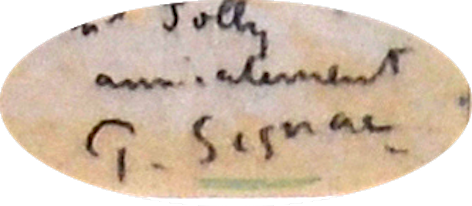

(1863 – Paris – 1935)

Paul Signac family settled in Montmartre as a child. He discovered Impressionist artworks very young and especially liked the ones of Gustave Caillebotte, Mary Cassatt, Edgar Degas, Claude Monet and Camille Pissarro.
Copying a work of Degas during an exhibition, he was thrown out by Paul Gauguin. The following year, his parents died, he sold the familial commerce and settled in Asnières. Signac, in addition to boat and navigation, is passionate by painting. He went to exhibition of Manet, then Monet.
Signac decided to stop his studies and to dedicate his time painting. In 1882, he met Berthe Roblès and married her in 1892. They frequented the cabaret Chat Noir, and he shared an atelier with Henri Rivière. He painted views of Montmartre and Asnières. Impressionism affected him and he realised feminine nudes. He met personalities of symbolism, as Felix Feneon, Gustave Kahn, Paul Adam and Jean Ajalbert. Huge fan of Claude Monet, he requested a meeting with him and they became friend.
At the first exhibition of Salon of Sur-Independents, he exhibited paintings showing influence of his master. He discovered a painting of Georges Seurat, Baignade à Asnières, on which the technic of separation of light and shadow in perfect harmony affected Signac. He met Seurat and advised him to use, as Impressionists, the pure colours and abandon muddy brown colours.
The two artists became friends and founded with Cross and Dubois-Pillet the Independents Artists Society. Seurat met the painter Guillaumin and introduced him Camille Pissarro. They all are seduced by technic and theories of Seurat, and Signac signed his first pointillist painting, The Modistes.
In May 1886, Paul Signac participated to the last exhibition of Impressionists with Neo-Impressionists including Seurat. During this exhibition, Signac exhibited his work La Grande Jatte. Their presence caused problems, Monet refusing to exhibit with them. They are finally present apart in a little room. At this moment, Signac entirely adopted the technic of Seurat the Pointillism. The art dealer Durand-Ruel presented a series of his paintings at American Art Gallery of New York. At Salon of Independents, he exhibited Embranchement, Bois-Colombes.
In 1887, he met Vincent Van Gogh and convinced him to evolve towards a clear painting. He bought a new boat and spent summer 1888 in Bretagne. Signac was a great traveller all his life. He exhibited in Brussels with Seurat at the Salon of XX. He became friend with the anarchist painter Maximilien Luce who adhered to Independents Society and participated actively at the exhibitions of the Group.
In 1888 Signac read in an article by Arsène Alexandre that others painters contest the paternity of Seurat on pointillism. Signac identifies with them and is offended: he always admitted that Seurat was the first to have the idea to practice the science applied to painting. After this incident, Signac has grown apart from Seurat. In 1889 he collaborated with Charles Henry to establish an aesthetic of lines. At Cassis, he visited Van Gogh interned at Arles Hospital. Van Gogh gave him a painting titled Nature morte aux harengs as thank-you gift.
In March 1889, Signac is very upset by the brutal death of Seurat at the age of 31. He exhibited at the Circle of XX in Brussels and in Independents. The painter is very isolated and became leader of Neo-Impressionist Group. Some dissents appear during the 7th exhibition of the Group. The paintings of Signac – including the portraits of Felix Fénéon – are very criticized by members of the Group, especially Pissarro and his son Lucien. In 1892 he discovered Saint-Tropez and built a house where he lives a large part of the year until 1911. He painted here seascapes.
At the beginning of 1893, he starts his painting Au Temps d’Harmonie. He organised exhibitions of the Group in Paris, first at Hotel Brebant, then in a gallery where he exhibited his painting with titles evoking music. Not everyone likes his painting: Gauguin is ironic about it and Octave Mirabeau reproaches him his insensitivity. Signac is furious but takes into account theses critics, and in 1896 he inserts more suppleness in his work, especially for his painting La Jetée de Flessingue and for the series on Mont Saint-Michel. He visited Pissarro in London and started the redaction of his essay on Eugène Delacroix, which is edited in 1899. In 1900 he participated at the preparation of the exhibition Seurat and exhibited at Aesthetic Free of Brussels.
In 1904, he exhibited five paintings at Independents and met Matisse who invited him in Saint-Tropez. Matisse paints the sketch of his masterpiece Luxe, Calme et Volupté applying principle of divisionism. Signac continues his journeys to Italia, Marseille, Rotterdam, Constantinople, and La Rochelle where he rents a house and paints with his friend Marquet.
He exhibited at the gallery Berheim-Jeune. In 1908, he is named Chairman of Independents Artists Society. In 1911, Renoir awarded him the insignia of Chevalier of Legion d’Honneur. He participated at the creation of Circle and Square, a grouping of left intellectual struggles against violation of individual freedom.
During the War he paints a little, afflicted by war’s horrors. He returns to his ports landscapes since 1918. He wrote Stendhal, art critic and published in 1927 a book on painter Jongkind. In 1933, he became member of Anti-fascist Intellectuals’ Vigilance Committee with André Gide, Paul Nizan and Marcel Cachin. He died in 1935 at the age of 72.